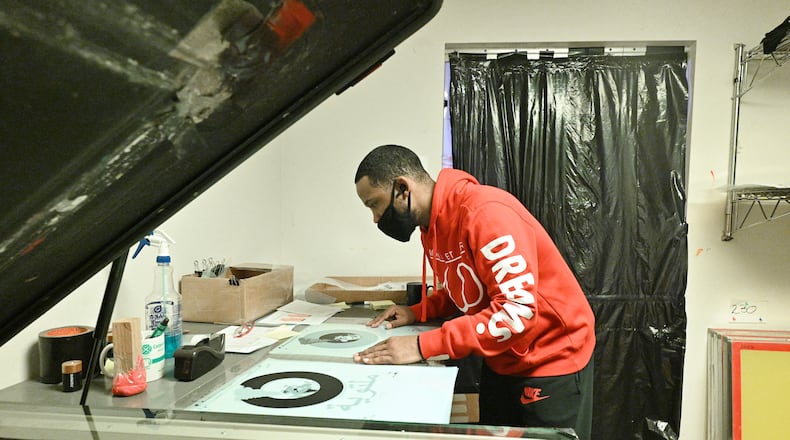Rejoice Jones learned what many other Georgia small business owners have slowly figured out — to get a federal relief loan, it pays to be persistent and to find a knowledgeable source.
The Atlanta company Jones founded, Vower, provides an online marketplace for young people to find unpaid internships and volunteer work. Those gigs dried up when the pandemic hit, and so did revenue for Jones’ business.
She applied last April to the Paycheck Protection Program, a massive federal loan program to help small businesses survive the pandemic. But her application was rejected.
Jones realized, after watching YouTube videos by personal-finance experts, that Vower did not have enough full-time employees to qualify. She resubmitted her PPP application as an independent contractor for her side gig as a freelance tutor.
That resulted in approval for two loans, one last spring and another in February of this year, totaling $3,875. She’s using the money to forgo pay for her Vower work. That’s allowed the fledgling company to survive.
“We were hanging on by less than a thread,” she said. “If the money hadn’t come when it did, we would have closed.”
Credit: HYOSUB SHIN / AJC
Credit: HYOSUB SHIN / AJC
Almost a year into the PPP loan program, many owners of tiny businesses still can’t access the money, often struggling to navigate the paperwork, eligibility requirements and rule changes.
About 77% of the $933 billion in PPP loan funds earmarked by Congress had been loaned out through March 21. In Georgia, businesses have received about 119,000 loans totaling about $20 billion. Congress and the Biden administration may extend the March 31 application deadline to the end of May in an effort to distribute more money.
The federal government also has tweaked the rules to make it easier for the smallest businesses to qualify. Virtually all of the changes came before this month’s passage of a new, $1.9 trillion federal stimulus package. The latest stimulus had only one direct impact on PPP, adding about $7 billion to the available funds.
The Small Business Administration’s most effective new rule changed the financial metric used to determine if a small business qualifies, said Stephen Klein, a partner at Atlanta accounting firm Bennett Thrasher. Last year, a business had to show a 25% drop in net income on a yearly basis to qualify.
“We were hanging on by less than a thread. If the money hadn't come when it did, we would have closed."
Many of the smallest businesses generate too little profit to produce a 25% year-over-year change, especially independent contractors and sole proprietors, Klein said. Now, a small business only needs to show a 25% decline in gross revenue, which should increase eligibility and allow for higher loan amounts.
In another tweak, the Biden administration limited PPP applications for a two-week period in February and March, allowing only businesses with fewer than 20 employees to apply. Loans to minority-owned businesses rose 20% during that window compared with the average daily rate 10 days earlier. Loans to women-owned businesses increased 14% and loans to small businesses in rural areas climbed 12%.
There’s still a common perception among rejected business owners that it’s difficult to get PPP approval, said Patrice Frey, CEO of National Main Street Center, which provides technical assistance to small businesses.
That’s a big reason why about $88 billion is still available from a second round of funding available since January. The government retired more than $100 billion in unused funds from the first round.
“It’s informed by the challenging experience people had in the first round,” Frey said. “Also, the most fragile businesses have already closed, which reduced the number of businesses who need the loans.”
For businesses owners who successfully obtained PPP loans, the proceeds have been essential to saving their businesses, said Joseph Shuford, director of government guaranteed lending at Synovus Financial.
“It’s been wildly successful,” he said. “It has saved hundreds of thousands of jobs across the country.”
Some financial experts have cited PPP loans as a big reason why the pace of small-business bankruptcies has been slower than expected. Still, economists consider bankruptcies to be a lagging indicator and the number of cases has been slowly increasing in recent months.
The size of PPP loans approved this year at Credit Union of Georgia in Woodstock has gotten smaller, said CEO Brian Albrecht. That suggests more of the smallest businesses are applying, since they need less money.
“The tweaks they made didn’t make it easier to get the loans, but it opened them up from a broader group of businesses,” Albrecht said.
At the most basic level, however, it’s difficult for the smallest businesses to submit applications, Frey said. Many lack bank accounts, especially businesses owned by people of color, and instead use cash, prepaid debit cards and smartphone apps to make and receive payments. Accounts are needed to prove a business’s revenue has fallen by the required amount during the pandemic.
“Documentation is always difficult for the smallest businesses,” Frey said.
Black and Latino small business owners were discouraged by what they perceived to be high PPP loan rejection rates in 2020 and many won’t apply this year, according to a January survey conducted by advocacy group Reimagine Main Street. Some 44% of Black and Latino business owners said they believed their applications would be rejected. Only 37% of white respondents expected rejection.
The SBA does not require PPP applicants to disclose their racial background, so there is not a complete picture of how many business owners of color applied.
Credit: Handout
Credit: Handout
Having an account at a credit union helped Axel Transport, a trucking company in Woodstock, get over the hump, said President Rita Dillard.
Axel recently lost its account to carry home-improvement products for Home Depot. Dillard and her husband, Reginald Johnson, who owns the business, applied for a PPP loan to survive until they could find a new customer.
A loan officer at Credit Union of Georgia in Cherokee County, where they’ve had an account for a decade, helped them gather the correct documents for the PPP loan application. Axel has received two PPP loans of $20,400 each from the credit union.
“We had to have that advice and guidance,” Dillard said.
About the Author
Keep Reading
The Latest
Featured





